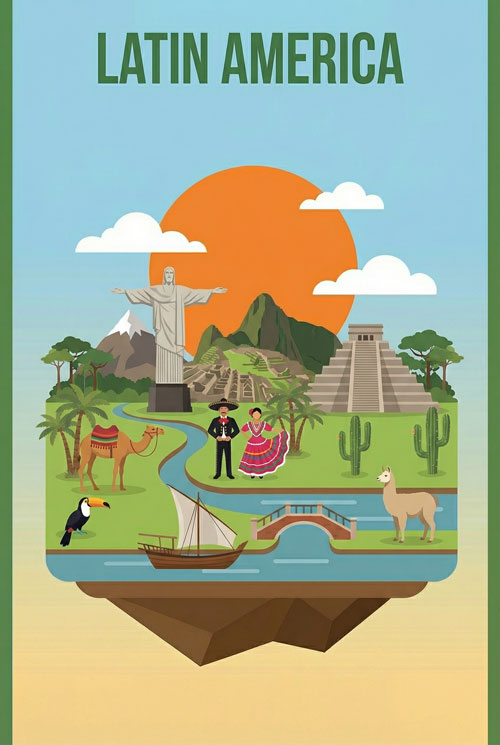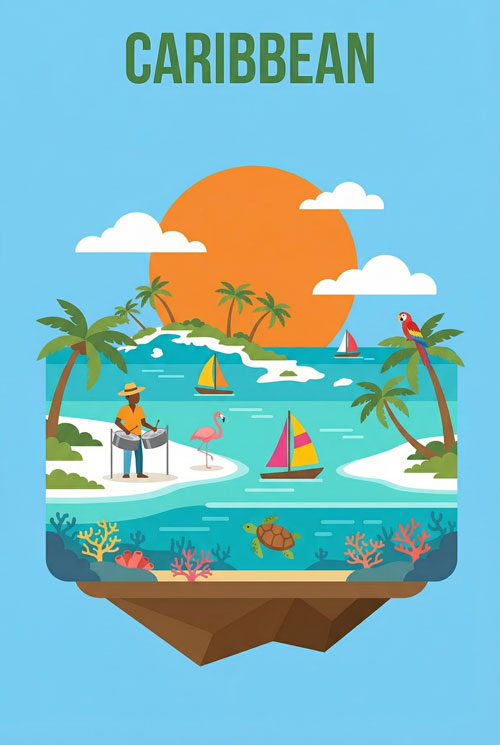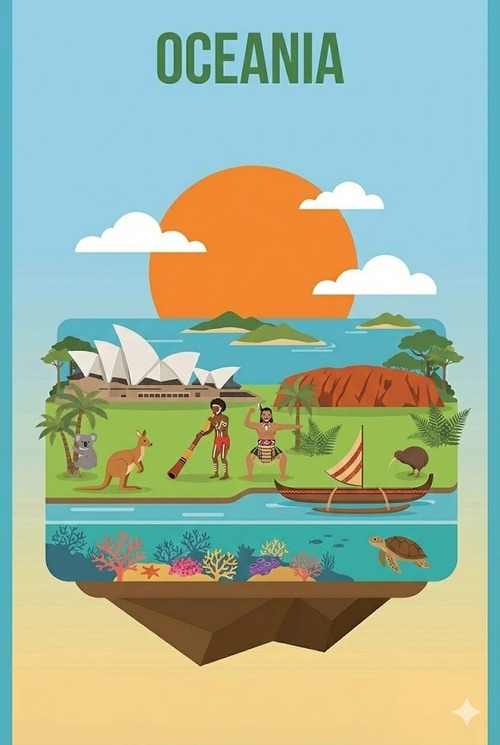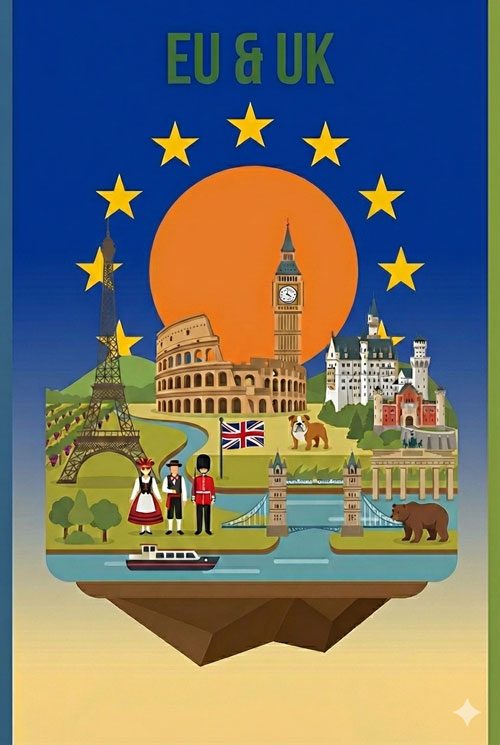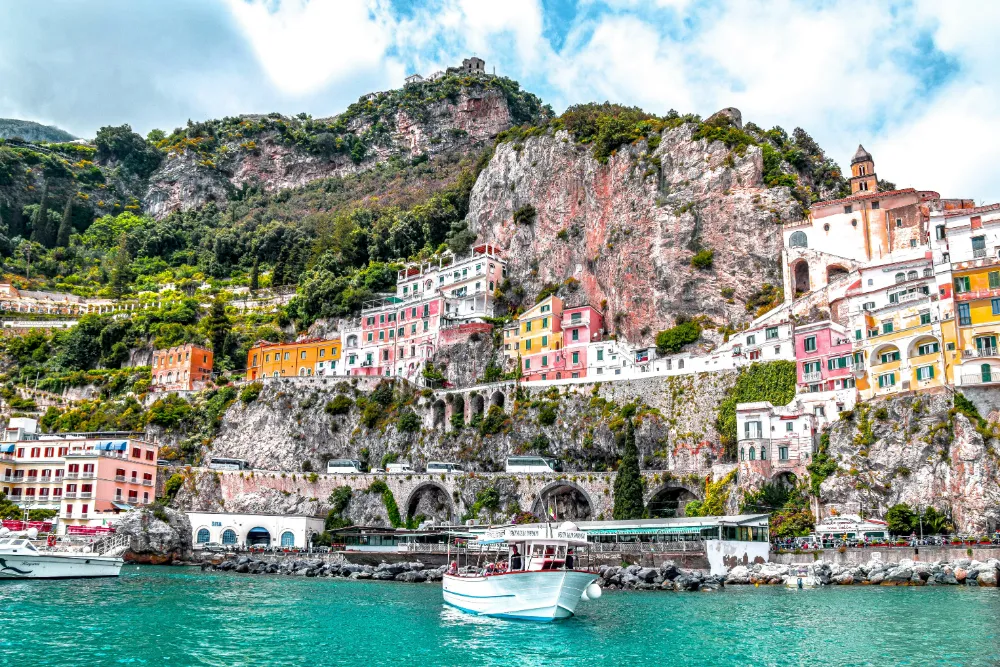Best Time To Visit, eSIM Italy
Best Time to Visit Amalfi Coast: Everything You Need To Know
Figuring out the best time for your Amalfi Coast adventure? While many say spring and autumn are ideal, your perfect trip truly depends on what you want from this stunning Italian paradise. This guide will help you explore all the options, matching your desires for weather, crowd levels, budget, and activities, so you can choose the perfect moment for an unforgettable experience.
The most popular advice points to April-May and September-October as fantastic times. You’ll likely find sunny days and fewer people than in the summer. But let’s dive deeper to find your ideal time.
Amalfi Coast: A Quick Glance – The Best Times Overall
So, when do most people find their bliss on the Amalfi Coast?
The Sweet Spots: Spring & Autumn Shoulder Seasons
Many travelers agree that April to May (spring) and September to October (autumn) are top choices. Why? You get a wonderful balance. Temperatures are usually pleasant, perfect for exploring. Think comfortable days ranging from 15−25∘C (59−77∘F) in spring, and 18−26∘C (64−79∘F) in autumn.
You’ll also find significantly fewer crowds compared to the busy summer months. This means a more relaxed vibe as you wander through charming towns. Most shops, restaurants, and attractions are open and ready to welcome you. The weather is great for sightseeing, hiking, and even boat trips. It’s a delightful mix of sunshine and comfortable exploration.
Imagine this: staying connected to share those breathtaking views or navigate winding roads is easier than ever. With an eSIM from eSIM4, you can get affordable mobile data that connects automatically when you arrive. No more hunting for local SIM cards!
Understanding the Trade-offs: A Visual Snapshot
To give you a quick picture, here’s a simple way to see how the seasons compare:
| Season | Weather | Crowd Levels | Prices | Vibe |
| Spring | Pleasant, Sunny | Moderate | Medium | Awakening, Lush |
| Summer | Hot, Sunny | Very High | High | Vibrant, Intense |
| Autumn | Warm, Mild | Moderate | Medium | Golden, Calm |
| Winter | Cool, Mixed | Low | Lower | Quiet, Authentic |
This little chart helps you see the main differences at a glance. Now, let’s get into the specifics of each season.
This “Invisible” SIM Card is Saving Ordinary Travellers Hundreds on International Trips
You see those travelers glide through airport arrivals – calm, internet connected, already booking their ride-share while others are frantically searching for Wi-Fi or queuing at chaotic phone kiosks…
What’s their secret?
When you travel overseas you’re either paying insanely high data-roaming fees from your home carrier or frantically hunting down some local SIM card kiosk the second you land, wasting precious vacation time just trying to get your phone working.
One leaves you with a bill that leaves a sour taste in your mouth after a great trip. The other eats into your actual holiday, causing stress and hassle when you should be exploring.
But what if I told you that ordinary travelers just like you have figured out a way to completely bypass this frustrating experience?
They’re using something most travelers don’t even know exists… a kind of “invisible” SIM card technology that you likely already have on your phone right now.
And it’s allowing them to tap into super-cheap, high-speed data anywhere in the world… without swapping cards, without visiting a store, and without getting ripped off.
It’s called an eSIM.
And eSIM4.com makes getting one simple.
Here’s how it works:
- Step 1: Go to eSIM4.com.
- Step 2: You pick your destination, choose a data plan.
- Step 3: We send you a simple QR code. You scan it with your phone’s camera.
Your new travel SIM is installed in under 3 minutes!
The moment your plane’s wheels hit the tarmac overseas? Your phone instantly connects to a fast, local network.
No queues. No fumbling with tiny plastic chips. No nasty bill shock.
Just seamless, affordable data letting you use Google Maps, WhatsApp, Uber, Instagram… whatever you need… right away.
This is how travel is supposed to work. And it’s saving people like you hundreds of dollars on a single trip.
Stop letting the big phone companies treat your travel budget like their personal ATM. Stop wasting your valuable vacation time being disconnected or stressed.
Join the smart travelers who’ve already made the switch.
CLICK HERE TO GET STARTEDA Deep Dive: The Amalfi Coast Through the Seasons
Each season paints the Amalfi Coast in a different light. What feels right for you?
Spring on the Amalfi Coast (April – Early June): Awakening Beauty
Spring is when the Amalfi Coast truly comes alive. Picture the landscape bursting with colorful wildflowers. The air often carries the sweet scent of orange blossoms. It’s a time of lush, green scenery. This makes it an amazing period for hiking, especially on famous trails like the Path of the Gods.
Temperatures typically range from 15−25∘C (59−77∘F). Crowd levels are generally moderate. They do start to pick up as June gets closer.
What can you do? Hiking is a must. Photography is rewarding. Exploring towns is pleasant without the summer heat. Early-season boat trips are also lovely. Keep an eye out for local spring festivals!
The sensory details of spring—the specific flowers blooming, the fresh scents—make activities like hiking even more special. It’s more than just “good weather”; it’s an experience.
Summer on the Amalfi Coast (Late June – August): Vibrant but Intense
Summer is high energy! It’s peak beach season. Evenings are lively, and the coast buzzes with festivals and concerts. The beaches will be packed, that’s for sure.
Temperatures get quite hot, often between 30−42∘C (86−108∘F). August is usually the warmest. Crowds are at their highest. Be prepared for traffic jams along the coast roads and packed towns.
Activities center around swimming, boating, and enjoying the vibrant nightlife. Summer festivals, like the Ravello Festival, are in full swing.
Here’s some crucial advice: book your accommodation and any popular tours far in advance. Consider using boats to get between towns. This can be a great way to skip the challenging road traffic. There’s often an alternating license plate system for cars, which can limit driving.
Knowing about summer’s downsides (heat, crowds, traffic) helps you plan. If you can only travel now, you can still have a great time with smart strategies.
Autumn on the Amalfi Coast (September – October): Golden Tranquility
Autumn brings a lovely golden hue to the coast. The sea often stays warm from the summer, especially in September. Daytime temperatures are pleasant for exploring. It’s also harvest season, so you might see grapes and chestnuts being gathered. Some travelers have found late October surprisingly warm with fewer people.
Temperatures generally range from 18−26∘C (64−79∘F). One recent year saw late October highs reach 27∘C (81∘F)! Crowds noticeably decrease, especially as October moves along. By late October, things can be quite peaceful.
You can still swim, particularly in early autumn. Hiking remains excellent. It’s a great time for food and wine experiences tied to the harvest. Exploring towns is comfortable. Do note that some beach clubs might start to close towards the end of October.
The specific pluses of late autumn, like the quiet atmosphere and lingering warmth, offer a different kind of charm.
Winter on the Amalfi Coast (November – March): Quiet & Authentic (But Limited)
Winter is a peaceful time. It offers a chance to see local life without the usual tourist buzz. The coastal scenery can be quite dramatic. It’s a great time if you prefer a quieter, more peaceful experience.
Temperatures are cooler, typically 8−15∘C (46−59∘F). The coast is much less busy from November to March. Crowds are very low.
What’s there to do? Explore towns without the crowds. Enjoy authentic local food. Admire traditional Nativity scenes (presepi) in December. Some hiking is possible on clear, crisp days.
However, there are limitations. Many hotels, restaurants, and shops, especially in smaller towns, may be closed or have shorter hours. Ferry services are often significantly reduced. The weather can be unpredictable, with a higher chance of rain and chilly winds.
Winter isn’t just an “off-season” to avoid. It’s a different experience with its own unique appeal. It’s especially good for budget-conscious travelers or those who really dislike crowds.
Amalfi Coast Seasonal Planning Matrix
Here’s a handy table to help you compare the seasons quickly. This can help you match your priorities with what each season offers.
| Factor | Spring (April-Early June) | Summer (Late June-August) | Autumn (September-October) | Winter (November-March) |
| Key Months | April, May, Early June | Late June, July, August | September, October | November, December, January, February, March |
| Avg. Temp Range | 15−25∘C (59−77∘F) | 30−42∘C (86−108∘F) | 18−26∘C (64−79∘F) (can be warmer late Oct) | 8−15∘C (46−59∘F) |
| Weather Summary | Warm, sunny, lush, wildflowers blooming | Hot, sunny, vibrant, peak sunshine | Pleasant, mild, sunny days, cooling gradually | Cooler, unpredictable, potential for rain and wind |
| Crowd Levels | Moderate (increasing towards June) | Very High (traffic jams common) | Decreasing (esp. Oct), manageable | Very Low |
| Rec. Activities | Hiking, exploring towns, photography, boat trips | Beaches, swimming, boating, festivals, nightlife | Hiking, exploring, food & wine, swimming (early Aut.) | Quiet town exploration, local cuisine, Nativity scenes |
| Key Festivals | Check local spring events (e.g., Easter) | Regatta of Ancient Maritime Republics, Ravello Festival, Sfogliatella Festival | Harvest festivals (grapes, chestnuts) | Christmas markets, New Year celebrations (localized) |
| Pros | Pleasant weather, blooms, fewer crowds | Guaranteed sun, lively, all open | Good weather, fewer crowds, harvest, warm seas (early) | Peaceful, budget-friendly, authentic local life |
| Cons | Crowds increase, services ramping up | Extreme heat, very crowded, higher prices, traffic | Beach clubs may close late, more rain later | Many closures, reduced ferries, cooler/wetter |
This matrix should make it easier to see which season lines up best with your dream Amalfi Coast trip!
Beyond the Seasons: Best Time for Specific Interests & Traveler Types
A generic “best time” doesn’t work for everyone. Your interests matter! Let’s find your perfect timing.
Get Outdoors: Best for Hikers & Nature Lovers
The sweet spots are April, May, September, and October. These months give you ideal temperatures for walking. Trails are clearer. Spring offers blooming flowers, while autumn brings rich colors. Summer heat is usually too much for serious hiking. The famous Path of the Gods is spectacular during these times.
Soak Up the Sun: Best for Beach Lovers
Plan your trip between June and September for the best beach weather. Sea temperatures are warmest then, often around 25−26∘C (77−79∘F) in July and August. All beach clubs and lidos will be open. Just be ready for crowded beaches, especially in July and August.
Travel Smart: Best for Budget Travelers
For the most savings, look at November to March. Just skip the Christmas and New Year holiday period. Late October and early April can also offer better deals on places to stay. You’ll find fewer paid attractions too. The trade-off is a quieter coast and some closed businesses.
Enjoy the Peace: Best for Avoiding Crowds
November to March is your best bet for very few tourists. If you want a balance of fewer crowds and nicer weather, try very early April or late October. You might focus on the main towns that stay active all year.
Experience Culture: Best for Events & Festivals
We’ll have a dedicated “Amalfi Coast Events Calendar Highlights” section below. But key events include the Feast of Sant’ Andrea in Amalfi (June and November) and the Ravello Festival (summer). Many local food festivals (sagre) also happen throughout the year.
Romantic Escapes: Best for Honeymooners
May, June, and September are often recommended. These months mix beautiful scenery with lovely weather. Perfect for romantic dinners outside, boat trips to quiet coves, and exploring charming towns like Positano and Ravello. These spots are wonderful for honeymoons.
Family Adventures: Best for Families
Late May/June or September can be great. You get pleasant weather, warm seas, and fewer crowds than peak summer. If July or August are your only options, book family-friendly places with pools. Plan outdoor time for cooler parts of the day. Use boats to avoid road traffic.
Staying Connected: eSIM vs. Traditional SIM Card
When you’re exploring the Amalfi Coast, staying connected is helpful. You’ll want to share photos, use maps, or look up restaurant reviews. You have a couple of main options for your phone: an eSIM or a traditional SIM card.
Traditional SIM Card
- Pros: Widely available, you can often buy them at airports or local stores. Good if you prefer a physical card.
- Cons: You need to physically swap out your home SIM card (risk of losing it!). Setup can sometimes be fiddly. You might need to register with passport details. Finding the best deal can take time.
- Best for: Travelers who are comfortable swapping SIMs, perhaps those on very long stays, or those who don’t have an eSIM-compatible phone.
eSIM (embedded SIM)
- Pros: Super convenient. No physical card to lose. You can often buy and set up your plan before you even leave home. For instance, with eSIM4, you can purchase your plan online, receive a QR code or link via email, and install it easily. Many, like ours, auto-connect to local networks on arrival. You can keep your home SIM for calls/texts if needed. Some providers, like eSIM4, offer apps to manage data, top up, or even buy virtual numbers and international call/text packages. This is great for managing everything in one place. Plus, 24/7 support is often available if you need help.
- Cons: Your phone needs to be eSIM compatible (most newer smartphones are). If you have an older phone, this might not be an option.
- Best for: Most modern travelers! Especially those who value convenience, want to get connected instantly upon arrival, and prefer managing their mobile data digitally. It’s perfect for short trips, multi-country itineraries in Europe (many eSIMs cover multiple countries), and anyone who wants a hassle-free setup.
For a trip to the Amalfi Coast, an eSIM offers a really smooth experience. Imagine stepping off the plane and your phone just works. No lines, no fuss. That’s a surprisingly nice way to start your vacation.
Month-by-Month on the Amalfi Coast: A Detailed Calendar
Want to get really specific? Here’s a closer look at each month. This level of detail helps you fine-tune your plans.
January on the Amalfi Coast
- Weather Snapshot: Cool, average temps 8−13∘C (46−55∘F). Some sunny days, but expect rain and wind.
- What to Expect: Very quiet. Many hotels and restaurants closed, especially in smaller villages.
- Key Highlights & Activities: Peaceful town exploration. Enjoy local life. Some hiking if weather permits.
- Events/Festivals: New Year’s Day. Epiphany (Jan 6th) celebrations.
- Pack This: Warm layers, waterproof jacket, umbrella, comfortable walking shoes.
February on the Amalfi Coast
- Weather Snapshot: Similar to January, 8−14∘C (46−57∘F). Still a chance of wet and windy days.
- What to Expect: Remains very quiet. Limited tourist services.
- Key Highlights & Activities: Enjoy the calm. Visit towns like Amalfi and Positano when they are least crowded.
- Events/Festivals: Carnevale (Mardi Gras) festivities in some towns if dates fall in Feb.
- Pack This: Warm clothing, rain gear, good shoes.
March on the Amalfi Coast
- Weather Snapshot: Starting to warm slightly, 10−16∘C (50−61∘F). More sunshine, but rain is still possible.
- What to Expect: Still quiet, but businesses may start preparing to open towards the end of the month.
- Key Highlights & Activities: Early signs of spring. Good for quiet walks.
- Events/Festivals: St. Joseph’s Day (March 19th).
- Pack This: Layers, light waterproof jacket.
April on the Amalfi Coast
- Weather Snapshot: Pleasant, 12−19∘C (54−66∘F). More sunny days. Wildflowers start blooming.
- What to Expect: Things come alive. More businesses open. Crowds are moderate.
- Key Highlights & Activities: Excellent for hiking. Easter celebrations (Pasqua) if they fall in April. Explore gardens.
- Events/Festivals: Easter processions and events.
- Pack This: Medium-weight clothing, layers, comfortable shoes.
May on the Amalfi Coast
- Weather Snapshot: Beautiful weather, 18−25∘C (64−77∘F). Mostly sunny. Perfect for outdoor activities.
- What to Expect: Vibrant with flowers. Pleasant atmosphere. Most businesses open. Crowds build towards month-end.
- Key Highlights & Activities: Ideal for hiking the Path of the Gods. Explore Villa Rufolo and Villa Cimbrone in Ravello. Boat trips.
- Events/Festivals: Check local listings for saint’s days or food festivals.
- Pack This: Layers for cooler evenings, sunhat, sunglasses, walking shoes.
June on the Amalfi Coast
- Weather Snapshot: Warm and sunny, 20−28∘C (68−82∘F). Sea is warm enough for swimming.
- What to Expect: Lively. Beach season begins. Crowds increase.
- Key Highlights & Activities: Beach time, swimming, boating. Explore towns. Start of Ravello Festival.
- Events/Festivals: Feast of Sant’ Andrea (Amalfi – June 27th). Republic Day (June 2nd).
- Pack This: Summer clothes, swimwear, sunblock, hat.
July on the Amalfi Coast
- Weather Snapshot: Hot and sunny, 23−35∘C (73−95∘F). Peak summer.
- What to Expect: Very busy and crowded. Lively atmosphere. Roads can be congested.
- Key Highlights & Activities: Beaches, boat trips (essential to escape crowds/traffic), nightlife. Ravello Festival continues.
- Events/Festivals: Various local festas and concerts.
- Pack This: Light summer clothing, swimwear, lots of sunblock, hat, reusable water bottle.
August on the Amalfi Coast
- Weather Snapshot: Hottest month, 24−40∘C (75−104∘F). Intense sun.
- What to Expect: Most crowded month. Vibrant but can be overwhelming. Ferragosto (Aug 15th) is a major holiday.
- Key Highlights & Activities: Similar to July. Early morning or late evening activities are best.
- Events/Festivals: Ferragosto celebrations. Sfogliatella Santa Rosa Festival (Conca dei Marini).
- Pack This: Very light clothing, maximum sun protection.
September on the Amalfi Coast
- Weather Snapshot: Still warm and sunny, 20−28∘C (68−82∘F). Sea remains warm. Evenings get a bit cooler.
- What to Expect: Crowds start to lessen, especially later in the month. Pleasant atmosphere.
- Key Highlights & Activities: Great for swimming and hiking. Harvest festivals. Explore towns more comfortably.
- Events/Festivals: Piedigrotta festival in some areas. Grape harvest festivals.
- Pack This: Summer clothes, a light jacket for evenings, swimwear.
October on the Amalfi Coast
- Weather Snapshot: Mild and often sunny, 16−24∘C (61−75∘F). Chance of rain increases later in the month.
- What to Expect: Quieter. Many find this month ideal. Some beach clubs may close.
- Key Highlights & Activities: Hiking, sightseeing. Chestnut harvest. Enjoy the autumn colors.
- Events/Festivals: Local autumn fairs and food festivals.
- Pack This: Layers, light jacket, comfortable shoes.
November on the Amalfi Coast
- Weather Snapshot: Cooler, 12−18∘C (54−64∘F). More rain and overcast days.
- What to Expect: Quiet. Many tourist-focused businesses close. Authentic local feel.
- Key Highlights & Activities: Explore towns peacefully. Enjoy local cuisine.
- Events/Festivals: Feast of Sant’ Andrea (Amalfi – Nov 30th). All Saints’ Day (Nov 1st).
- Pack This: Warmer layers, waterproof jacket, umbrella.
December on the Amalfi Coast
- Weather Snapshot: Coolest, 8−14∘C (46−57∘F). Mix of sun and rain.
- What to Expect: Quiet, but becomes festive around Christmas. Some closures continue.
- Key Highlights & Activities: Christmas markets. Admire presepi (Nativity scenes). Enjoy festive lights.
- Events/Festivals: Christmas Eve, Christmas Day, New Year’s Eve celebrations.
- Pack This: Warm coat, scarf, gloves, rain gear.
Practical Considerations for Planning Your Amalfi Coast Trip
A little planning goes a long way on the Amalfi Coast.
How Long Should You Stay on the Amalfi Coast?
Most people suggest at least 3-5 days to see the main highlights. This gives you a taste of towns like Positano, Amalfi, and Ravello.
For a more relaxed trip, aim for 7-10 days. This allows for deeper exploration, more beach time, and maybe a day trip to Capri or Pompeii. Your timing can influence this; shorter trips fit well into shoulder seasons to maximize good weather.
Getting Around: How Seasons Affect Transport
You have options: SITA buses, ferries, rental cars, or private drivers.
- Ferries: Great in spring, summer, and early autumn. Frequent and offer stunning views. Services are much reduced in winter.
- Buses: Run year-round but can be very crowded, especially in summer. A good budget option.
- Cars: Driving offers flexibility but can be very challenging in peak summer. Roads are narrow, winding, traffic is heavy, and parking is scarce and expensive. An alternating license plate system often restricts access. Driving is easier in the off-season.
- Private Drivers: Most comfortable, most expensive. Good for stress-free transfers.
Staying connected while navigating is a breeze with an eSIM. For example, eSIM4 provides reliable data across Italy, and you can even use their app to get a virtual number if you need to make local calls.
Accommodation: When to Book
- High Season (Summer): Book many months in advance. Seriously. Popular places sell out fast.
- Shoulder Seasons (Spring/Autumn): Book a few months ahead, especially for sought-after spots.
- Low Season (Winter): More flexibility, but it’s still good to book ahead, especially if you have specific places in mind. Some hotels close, limiting options.
What About Rain? Amalfi Coast Rainy Season
The rainiest time is usually late autumn and winter (November to February).
It’s typically not constant rain for days on end. Expect intermittent showers or some overcast days. Pack a light raincoat or umbrella. There are still things to do: explore museums, enjoy cozy meals, or visit towns with covered walkways.
Amalfi Coast Events & Festivals Calendar Highlights
Joining a local festival can make your trip extra special! Here are some key annual events. (Dates can vary, so always check local listings closer to your travel time.)
- February/March: Carnevale (Mardi Gras) – Parades and costumes in various towns.
- April: Pasqua (Easter) – Solemn processions and celebrations.
- May/June/July (rotating): Regatta of the Ancient Maritime Republics – Historic boat race hosted by Amalfi (among others).
- June: Feast of Sant’ Andrea (Amalfi, June 27th) – Processions for Amalfi’s patron saint.
- June – August: Ravello Festival – Prestigious arts and music festival.
- August: Sfogliatella Santa Rosa Festival (Conca dei Marini) – Celebrating the famous pastry!
- August 15th: Ferragosto – Major national holiday with local festivities.
- September/October: Various Sagre (food festivals) celebrating local produce like grapes and chestnuts.
- November: Feast of Sant’ Andrea (Amalfi, Nov 30th) – Another celebration for the patron saint.
- December: Christmas markets, Presepi (Nativity scenes), New Year’s Eve fireworks.
Frequently Asked Questions (FAQs) about Visiting the Amalfi Coast
Here are quick answers to some common questions.
What is the absolute best month to visit the Amalfi Coast?
Many say May and September are ideal. They offer a great mix of beautiful weather, fewer crowds than summer, and everything open. But remember, “best” depends on what you want!
When is the worst time to visit the Amalfi Coast?
Peak summer (July/August) can be challenging due to extreme heat, huge crowds, and high prices. Deep winter (January/February) has limitations like cooler, wetter weather and many business closures. But these times might still suit some travelers.
What is the most crowded month on the Amalfi Coast?
August is typically the most crowded, followed closely by July.
What is the hottest month on the Amalfi Coast?
July and August are the hottest. Temperatures often go above 30∘C (86∘F) and can reach 40∘C (104∘F).
Is the Amalfi Coast expensive to visit?
It’s generally seen as an upscale destination. Costs vary a lot by season. Peak summer is the most expensive. The low season offers better value.
How many days do I need for the Amalfi Coast?
A minimum of 3-5 days is good for the highlights. For a more relaxed and thorough trip, 7-10 days is better.
Your Unforgettable Amalfi Coast Adventure Awaits
So, the “best time” to visit the Amalfi Coast is truly your call. While spring (April-May) and autumn (September-October) usually offer that magical blend of great weather and manageable crowds, every season has its own charm.
Think about what matters most to you: sunshine, peace and quiet, cultural events, or budget-friendly travel. Use this guide to help you pick the perfect time for your dream trip.
The Amalfi Coast, with its breathtaking views, charming towns, and rich culture, is waiting to give you an unforgettable journey. Start planning your adventure today!








